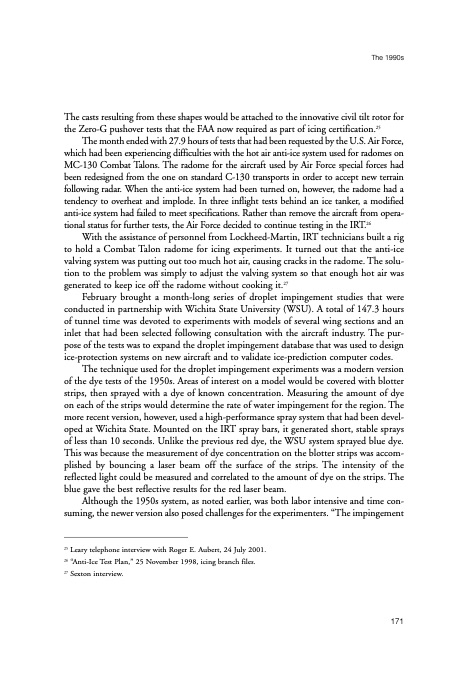
PDF Publication Title:
Text from PDF Page: 182
The casts resulting from these shapes would be attached to the innovative civil tilt rotor for the Zero-G pushover tests that the FAA now required as part of icing certification.25 The month ended with 27.9 hours of tests that had been requested by the U.S. Air Force, which had been experiencing difficulties with the hot air anti-ice system used for radomes on MC-130 Combat Talons. The radome for the aircraft used by Air Force special forces had been redesigned from the one on standard C-130 transports in order to accept new terrain following radar. When the anti-ice system had been turned on, however, the radome had a tendency to overheat and implode. In three inflight tests behind an ice tanker, a modified anti-ice system had failed to meet specifications. Rather than remove the aircraft from opera- tional status for further tests, the Air Force decided to continue testing in the IRT.26 With the assistance of personnel from Lockheed-Martin, IRT technicians built a rig to hold a Combat Talon radome for icing experiments. It turned out that the anti-ice valving system was putting out too much hot air, causing cracks in the radome. The solu- tion to the problem was simply to adjust the valving system so that enough hot air was generated to keep ice off the radome without cooking it.27 February brought a month-long series of droplet impingement studies that were conducted in partnership with Wichita State University (WSU). A total of 147.3 hours of tunnel time was devoted to experiments with models of several wing sections and an inlet that had been selected following consultation with the aircraft industry. The pur- pose of the tests was to expand the droplet impingement database that was used to design ice-protection systems on new aircraft and to validate ice-prediction computer codes. The technique used for the droplet impingement experiments was a modern version of the dye tests of the 1950s. Areas of interest on a model would be covered with blotter strips, then sprayed with a dye of known concentration. Measuring the amount of dye on each of the strips would determine the rate of water impingement for the region. The more recent version, however, used a high-performance spray system that had been devel- oped at Wichita State. Mounted on the IRT spray bars, it generated short, stable sprays of less than 10 seconds. Unlike the previous red dye, the WSU system sprayed blue dye. This was because the measurement of dye concentration on the blotter strips was accom- plished by bouncing a laser beam off the surface of the strips. The intensity of the reflected light could be measured and correlated to the amount of dye on the strips. The blue gave the best reflective results for the red laser beam. Although the 1950s system, as noted earlier, was both labor intensive and time con- suming, the newer version also posed challenges for the experimenters. “The impingement The 1990s 25 Leary telephone interview with Roger E. Aubert, 24 July 2001. 26 “Anti-Ice Test Plan,” 25 November 1998, icing branch files. 27 Sexton interview. 171PDF Image | History of NASA Icing Research Tunnel

PDF Search Title:
History of NASA Icing Research TunnelOriginal File Name Searched:
sp4226.pdfDIY PDF Search: Google It | Yahoo | Bing
NFT (Non Fungible Token): Buy our tech, design, development or system NFT and become part of our tech NFT network... More Info
IT XR Project Redstone NFT Available for Sale: NFT for high tech turbine design with one part 3D printed counter-rotating energy turbine. Be part of the future with this NFT. Can be bought and sold but only one design NFT exists. Royalties go to the developer (Infinity) to keep enhancing design and applications... More Info
Infinity Turbine IT XR Project Redstone Design: NFT for sale... NFT for high tech turbine design with one part 3D printed counter-rotating energy turbine. Includes all rights to this turbine design, including license for Fluid Handling Block I and II for the turbine assembly and housing. The NFT includes the blueprints (cad/cam), revenue streams, and all future development of the IT XR Project Redstone... More Info
Infinity Turbine ROT Radial Outflow Turbine 24 Design and Worldwide Rights: NFT for sale... NFT for the ROT 24 energy turbine. Be part of the future with this NFT. This design can be bought and sold but only one design NFT exists. You may manufacture the unit, or get the revenues from its sale from Infinity Turbine. Royalties go to the developer (Infinity) to keep enhancing design and applications... More Info
Infinity Supercritical CO2 10 Liter Extractor Design and Worldwide Rights: The Infinity Supercritical 10L CO2 extractor is for botanical oil extraction, which is rich in terpenes and can produce shelf ready full spectrum oil. With over 5 years of development, this industry leader mature extractor machine has been sold since 2015 and is part of many profitable businesses. The process can also be used for electrowinning, e-waste recycling, and lithium battery recycling, gold mining electronic wastes, precious metals. CO2 can also be used in a reverse fuel cell with nafion to make a gas-to-liquids fuel, such as methanol, ethanol and butanol or ethylene. Supercritical CO2 has also been used for treating nafion to make it more effective catalyst. This NFT is for the purchase of worldwide rights which includes the design. More Info
NFT (Non Fungible Token): Buy our tech, design, development or system NFT and become part of our tech NFT network... More Info
Infinity Turbine Products: Special for this month, any plans are $10,000 for complete Cad/Cam blueprints. License is for one build. Try before you buy a production license. May pay by Bitcoin or other Crypto. Products Page... More Info
| CONTACT TEL: 608-238-6001 Email: greg@infinityturbine.com | RSS | AMP |